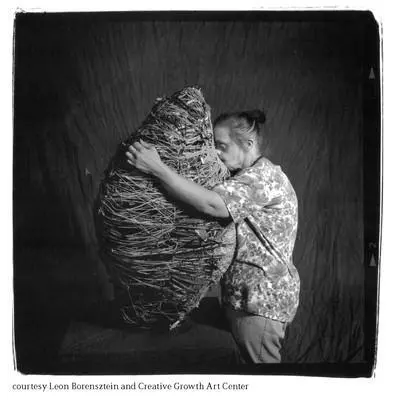Inside and Outside
I bike down Mission Street into the SoMa district. It’s midday and fairly warm, but passing an area of leather bars I see there are guys standing outside in full macho gay regalia. They must be suffering on a hot day like this, but maybe that’s the point. This part of town is flat, as it was created by landfill dumped over the rotting hulls of ships, so it feels different, slightly outside of the center of town, even though it’s right next to it. I stop to see an art show at the Yerba Buena Center featuring work that comes out of a place in Oakland called Creative Growth. Creative Growth is a visual arts center for people who are mentally and/or psychologically challenged. As a fan of a lot of what is often called outsider art I love some of this work.

One of these artists, Judith Scott, obsessively wrapped things in yarn and twine, creating almost life-sized cocoons that are powerful, affecting, and sort of creepy. Giant totemic objects, talismans that seem to hold some mysterious personal juju.
Another man, Dwight Mackintosh, did drawings that, as one studies them, are revealed to be composed of many layers of images, like stop-motion photos, all transparent and superimposed. They’re like those images that we’ve seen in old animated cartoons when a character moves super-rapidly and you see a dozen images of the character’s legs simultaneously, all overlapping to indicate speed. In Mackintosh’s line drawings there are so many arms and legs overlapping it’s hard at first to tell exactly what motion is being depicted or what the character is doing. Then it becomes clear—that’s a hand, that’s a . . . oh, it’s a penis. They’re all masturbating. At high speed, it seems.

The term outsider, as it is used in the art world, means “we are not sure this belongs in here, the artist is untrained, and maybe naive, but have a look.” It also sometimes implies self-taught and probably insane or not socially functioning in the accepted sense. (That could include a lot of us.)
On a nearby wall there are a series of black-and-white photos of the Creative Growth artists. Some of these photos I find disturbing. Not having seen what the artists look like previously, just having been moved deeply by their work, I mentally place and rank them alongside the best contemporary artists practicing today. Qualitatively, objectively, I don’t see any difference between their work and that of mainstream fine artists—except for the fact that there is no work here that deals with the hermetic and convoluted dramas of the art world itself. This, for me, is no great loss; in fact it’s more or less a plus—though some self-reflexive art is indeed funny. Anyway, I half expect them to look “normal,” or at least like other artists I know.
However, seeing the picture of Judith Scott, who has Down syndrome, makes me realize that many of these folks could never function in the gallery/museum system.
There, then, is what relegates them as outsiders. These artists may not have the perspective on their work that we expect a professional artist to have—not that most professional artists can talk lucidly about their own work either, but professionals at least have a sense of how their work fits into the world at large, or into the art market, and can fake the talk pretty well. We presume that the work of a professional artist is slightly separate from the artist as a person—you don’t have to know about Picasso’s mistresses and his psychological hang-ups and obsessions to like his paintings. With the Creative Growth artists and some other outsiders, however, it seems that for many people, personal information about the artist is considered essential to judging, evaluating, and understanding her work. The fact that they are self-taught, “crazy,” grew up in a swamp, or worked during the day as a janitor is somehow considered relevant. Jackson Pollock worked as a janitor at an elementary school in New York, and probably stole some paint from there too, but wall plaques in museums don’t describe him as a former janitor. While professional artists distance themselves and their lives somewhat from their work, Judith obviously has an intimate relationship with hers that I imagine many professionals might envy and wish they could have.

Though some professionals claim they’d like to eliminate the gap, and work in the territory between art and life as Bob Rauschenberg once claimed, these folks have never even left that gap—for them it’s not a gap but a deep chasm.
Comparisons between these artists and art professionals begs the question: what is sanity, and does being dysfunctional sometimes make you a better artist? I don’t think it does, though the Van Gogh myth of the crazy (genius) artist remains alive and well. I think those questions, that dichotomy between intention and result, might be irrelevant. For me, a stain on the sidewalk or a blob of construction insulation may have an aesthetic value equal to some works by Franz West, for example. One just happens to be on a stand in a museum and the other is usually found discarded in a vacant lot. My definition of what is good art is, I’m afraid, pretty wide, and it isn’t determined by the biography of its creator. Sometimes, for me, art doesn’t even need an author. I don’t care who or what made it. For me the art happens between the thing—any thing—and the viewer’s eye (or mind). Who or what made it is irrelevant. I don’t need to see their CV to like it. But I have to admit that sometimes the artist’s story, if I am informed of it, adds to and affects what I see.
If you obsessively scribble on bits of paper, as hugely successful artist Louise Bourgeois does some of the time (to pick an obvious example), is your work better than some very similar work by one of the folks at Creative Growth because you have more objectivity about your own work? Is scribbling better art when it has a conscious intention? Is it better work when you’re aware that you’re scribbling and could do other kinds of drawing if you really wanted to? I don’t think there is any way one could objectively say that of the two works one is better or worse than the other. Louise Bourgeois certainly does other kinds of work too, which might make some kind of difference, at least to some people, but the biggest difference I can come up with is that presumably she decided to make her obsessive scribbles consciously, and deliberately, and, we assume (big assumption here), wasn’t simply driven to make the marks by some unconscious impulse. This is really a big assumption, especially in her case, because she makes a big deal about her fucked-up childhood, so maybe she needs to scribble just as much as the Creative Growth folks.
And the real question is, would it make any difference if she does?
Social functionality, to me, is the key word in the inside/ outside dichotomy, not sanity. Many “sophisticated” and successful gallery artists are quite mad, lost in their own worlds, and often they are emotional wrecks—but they do know how to navigate the shoals and reefs of the art world. Well, a bit. They can compose themselves and posture sufficiently to get by, to talk the talk and walk the walk, though some of the successful ones might also be drooling drug addicts and conversational incompetents.
For the folks at Creative Growth making art is therapeutic. I would argue that it is equally therapeutic for the professional artist. I can personally testify that making music and performing have kept me more or less sane and allowed me a measure of social contact I might otherwise never have had. (Viewing art, however, is not therapeutic, nor does collecting art have any morally uplifting value—but that’s another topic. But the act of making it is.)
Читать дальше












